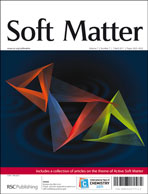Mechanisms of soft cellular tissue bruising. A particle based simulation approach†
Abstract
This paper is concerned with modeling the mechanical behavior of cellular tissue in response to dynamic stimuli. The objective is to investigate the formation of bruises and other damage in tissue under excessive loading. We propose a particle based model to numerically study cells and aggregates of cells described on to subcellular detail. The model focuses on a parenchyma cell type in which two important features are present: the cell's interior liquid-like phase inducing hydrodynamic phenomena; and the cell wall, a viscoelastic-plastic solid membrane that encloses the protoplast. The cell fluid is modeled by a Smoothed Particle Hydrodynamics (SPH) technique, while for the cell wall and cell adhesion a nonlinear discrete element model is proposed. Failure in the system is addressed to either cell wall rupture or to debonding of the middle lamella. We show that the model is able to reproduce


 Please wait while we load your content...
Please wait while we load your content...